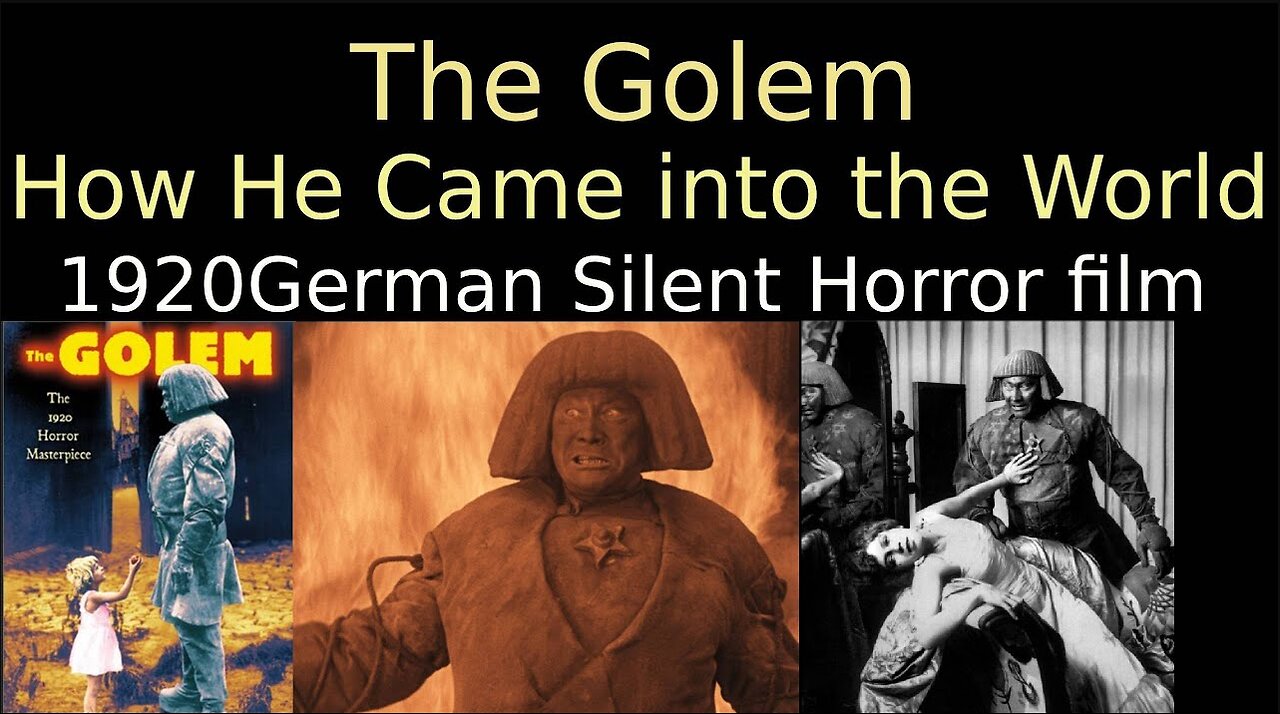Premium Only Content

The Golem: How He Came into the World (1920 German Silent Horror film)
The Golem: How He Came into the World (German: Der Golem, wie er in die Welt kam, also referred to as Der Golem) is a 1920 German silent horror film and a leading example of early German Expressionism.
Director Paul Wegener, who co-directed the film with Carl Boese and co-wrote the script with Henrik Galeen based on Gustav Meyrink's 1915 novel, stars as the titular creature, a being in Jewish folklore created from clay. Photographer Karl Freund went on to work on the 1930s classic Universal horror films years later in Hollywood.
The Golem: How He Came into the World is the third of three films that Wegener made featuring the golem, the other two being The Golem (1915) and the short comedy The Golem and the Dancing Girl (1917), in which Wegener dons the golem make-up in order to frighten a young lady with whom he is infatuated. The Golem: How He Came into the World is a prequel to The Golem from 1915 and, as the only one of the three films that has not been lost, is the best known of the series.
Plot
Set in the Jewish ghetto of medieval Prague, the film begins with Rabbi Loew, the head of the city's Jewish community, reading the stars. Loew predicts disaster for his people and informs the elders of the community. The next day the Holy Roman Emperor signs a decree declaring that the Jews must leave the city before the new moon and sends the squire Florian to deliver the decree. Loew, meanwhile, begins to devise a way of defending the Jews.
Upon arriving at the ghetto, the arrogant Florian is attracted to Miriam, Loew's daughter, for whom his assistant also feels affection. Loew talks Florian into reminding the Emperor that he has predicted disasters and told the Emperor's horoscopes, and requests an audience with him. Having flirted with Miriam, Florian leaves. Loew begins to create the Golem, a huge being made of clay which he will bring to life to defend his people.
Cast
• Albert Steinrück as Rabbi Loew
• Paul Wegener as The Golem
• Lyda Salmonova as Miriam
• Ernst Deutsch as Loew's assistant
• Lothar Müthel as Squire Florian
• Otto Gebühr as Emperor
• Hans Stürm as Rabbi Jehuda
• Max Kronert as The Gatekeeper
• Greta Schröder as A Lady of the Court
• Loni Nest as Little Girl
• Fritz Feld as A Jester
Production
Wegener had been unhappy with his 1915 attempt at telling the story, due to compromises he had to make during its production. His 1920 attempt was meant to more directly convey the legend as he heard it told in Prague while he was filming The Student of Prague (1913).
In 1919, Wegener announced plans for Alraune und der Golem, uniting the two folklore characters in one film. Though posters and other publicity material survive, it was almost certainly never made. Instead, Wegener produced his 1920 film, but later starred as Professor Jakob ten Brinken in the 1928 version of Alraune.
It was shot at the Tempelhof Studios in Berlin. Architect and designer Hans Poelzig created the film's scenery as a highly stylized interpretation of the medieval Jewish ghetto of Prague.
Release and reception
In Germany, the film received a stellar reception. According to Spiro, the film "sold out the Berlin Premiere at Ufa-Palast am Zoo on October 29, 1920, and played to full theaters for two months straight."
The film first released in the United States to packed houses in New York City in 1921 at the Criterion Theater. It was the longest-running movie in the same theatre that year, having run for 16 consecutive weeks in the theatre. Despite the hot summer, the film screened to full theaters daily, multiple times a day. Its release started a so-called "golem cult" of golem-related media and adaptations.
-
 LIVE
LIVE
Precision Rifle Network
6 hours agoS3E8 Guns & Grub - the craziness continues
589 watching -
 41:37
41:37
Kimberly Guilfoyle
7 hours agoPresident Trump Making all the Right Moves,Live with Border Union Chief Paul Perez & Lawyer Steve Baric | Ep. 176
115K23 -
 19:38
19:38
Neil McCoy-Ward
10 hours agoMASS LAYOFFS Have Started... (How To Protect Your Income)
26.2K7 -
 46:21
46:21
PMG
22 hours ago $0.10 earned"Venezuelan Gang in 16 States, Animal Testing Crackdown, & Trump’s Nominee Battle"
15.4K7 -
 LIVE
LIVE
VOPUSARADIO
9 hours agoPOLITI-SHOCK! WW3!?, BREAKDOWN OF THE WORLD EVENTS & R.A.G.E. (What it means & What's next!)
168 watching -
 1:00:10
1:00:10
The StoneZONE with Roger Stone
6 hours agoWhy Democrats Hold Poor Children Hostage in Failing Schools | The StoneZONE w/ Roger Stone
42.6K7 -
 LIVE
LIVE
Tundra Gaming Live
6 hours ago $0.12 earnedThe Worlds Okayest War Thunder Stream//Air Force Vet Flys Jets
231 watching -
 2:00:54
2:00:54
Redacted News
8 hours agoBREAKING! Putin just SHOCKED the world, launches nuclear capable warheads "NATO can't stop it"
179K509 -
 55:37
55:37
Candace Show Podcast
7 hours agoMatt Gaetz Out, Jussie Smollett Walks Free! | Candace Ep 108
141K344 -
 54:43
54:43
LFA TV
1 day agoTrump Has Learned His Lesson | Trumpet Daily 11.21.24 7PM EST
34.7K9